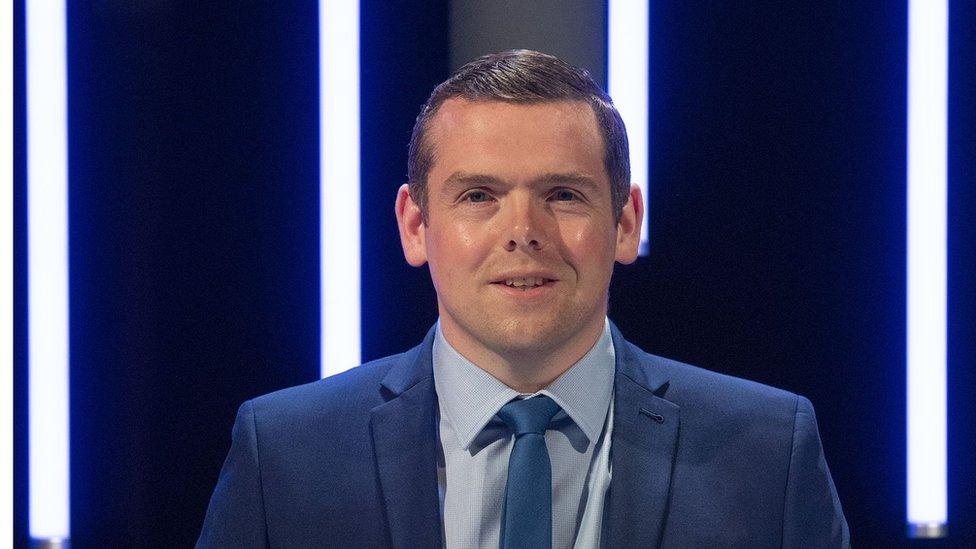Scottish election 2021: Fact-checking the leaders' debate
- Published

In their last televised debate of the 2021 Holyrood election campaign, the five leaders of Scotland's larger political parties traded claims on tax, the pandemic and social care.
We've looked at some of them.
Nicola Sturgeon (SNP): 'We reformed the tax system in the last parliament - we raised more revenue out of it'
This is correct but needs context.
From 2018, there has been a different regime for Scottish income tax payers, using newly devolved powers.
Lower earners pay a lower rate on a small tranche of their money, meaning they pay £21 per year less than someone on the same pay in the rest of the UK.
The main changes:
introduced additional tax bands
put up the main rates by 1%
raised the amount taxpayers pay on earnings above about £28,500 - and, even more steeply, to 41% above £43,663

Nicola Sturgeon, Scottish National Party leader
And this had been expected to raise, last financial year, £456m more than if Westminster's tax bands and rates had been used.
But there has been slower growth in the Scottish tax base and in revenue than there would have been without devolved income tax.
And so, the Institute for Fiscal Studies (IFS) reports, the changes actually raised an extra £117m.
For the current financial year, however, the Scottish Fiscal Commission expects them to raise £494m more than if Westminster's tax regime had been used.
Although, this assumes income-tax revenue in Scotland takes a proportionately smaller hit from Covid than in the rest of the UK, and, as with much current budgeting, is a very rough forecast with lots of uncertainty.
Douglas Ross (Conservative): '1.1 million people in Scotland are taxed more for doing the same job than the rest of the UK'
This is correct but needs context.

Douglas Ross, Scottish Conservative leader
The key differences are:
the 19% and 21% rates either side of the basic 20% rate
the 1% rise on the higher and top rates
The IFS says, external:
888,000 people now pay the 21% rate
322,000 pay the 41% rate
15,000 pay the 46% rate
That is a total of 1.2 million people paying more.
And the threshold for paying the higher rates is lower in Scotland than the rest of the UK.
More than half Scottish taxpayers have incomes below £27,393.
And they now pay £21 per year less than someone on the same pay in the rest of the UK, the IFS says.

Anas Sarwar, Scottish Labour leader
Anas Sarwar (Labour): 'A disproportionate number of people that earn over [£150,000] actually work in our public sector anyway, so they aren't going anywhere.'
Mr Sarwar was asked if his planned 5% rise on the top rate of income tax would make people earning more than £150,000 a year leave Scotland.
About 15,000 people in Scotland earn more than £150,000.
And 21% of workers in Scotland are in the public sector, Scottish government documents, external show.
So a "disproportionate" number would imply more than 3,150 people earning more than £150,000 worked in the public sector.
But we cannot find a breakdown of how many top earners work in the public or private sector.
Ms Sturgeon is the only minister who earns more than £150,000 - and one civil servant, external earns that much.
Public-sector chief executives have their basic pay, external capped at about £150,000 - but other compensation can take them well above that level.
Some doctors and surgeons may also earn more than £150,000.
Patrick Harvie (Greens): 'We know that a great deal of the reason why we had a second wave was importation of new cases'
Mr Harvie was expressing caution about easing restrictions on international travel.
And a scientific report, external released in early December said many cases detected early in the second wave of Scotland's epidemic could be traced back to travel abroad in July and August last year.

Patrick Harvie, Scottish Greens co-leader
Between 17 July and 30 August, researchers studying the genomic history of the virus estimated, there had been 46 "import events" into Scotland, where the virus was "reseeded" into the population:
28 from England
13 from mainland Europe
four from Asia
one from Wales
And their report said the European "lineages" had led to the most spread of the virus.
Later in December, however, public health officials warned of the spread of a new variant of the virus, identified in Kent, which was more infectious.

POLICIES: Who should I vote for?
PODLITICAL: Updates from the campaign


Willie Rennie, Scottish Liberal Democrat leader
Willie Rennie (Liberal Democrats): 'We have got a 20% vacancy [rate] in social care'
All five leaders were asked about their plans for Scotland's social-care sector, put under strain by the pandemic.
But we have been unable to find evidence to support Mr Rennie's claim that 20% of job roles are unfilled.
In 2019, according to the Care Inspectorate and Scottish Social Services Council data, external, the rate of full-time vacancies for care services in Scotland was 6.2%, up from 5.5% in 2018.
Figures for 2020 are yet to be published.
But, according to an independent review of adult social care in Scotland, external published in February, the annual turnover rate for staff in the Scottish social-care sector is 30%.
We asked the Lib Dems where they got their figure from. An official told us it came from a GMB union report, external which - in turn - quoted an article from the Times which didn't source the figure.

LOOK-UP TOOL: How many cases in your area?
GLOBAL SPREAD: How many worldwide cases are there?
QUARANTINE: Will I need to self-isolate in a hotel?
EPIDEMIC v PANDEMIC: What's the difference?
NEW VARIANTS: How worried should we be?




